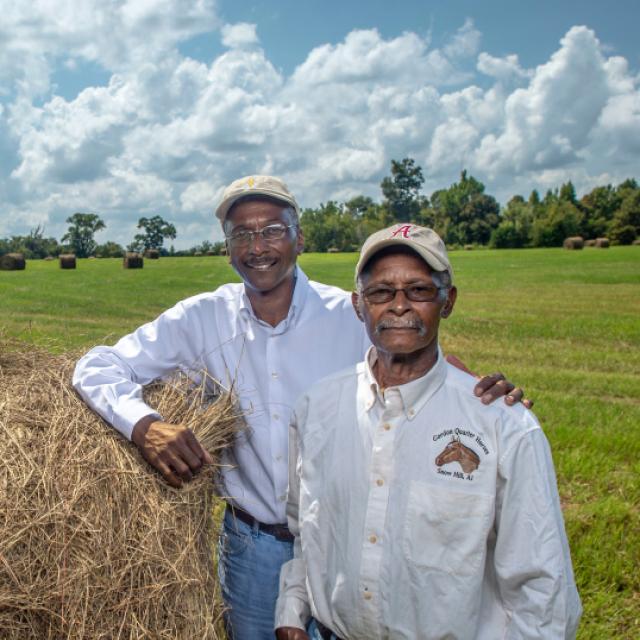EWP Success Stories
The Emergency Watershed Protection Program helps communities recover from natural disasters. The following success stories illustrate the agility of EWP to provide recovery assistance.


The Emergency Watershed Protection (EWP) Program, a federal emergency recovery program, helps local communities recover after a natural disaster strikes.
OVERVIEW
The EWP Program offers technical and financial assistance to help local communities relieve imminent threats to life and property caused by floods, fires, windstorms and other natural disasters that impair a watershed. EWP does not require a disaster declaration by federal or state government officials for program assistance to begin. The NRCS State Conservationist can declare a local watershed emergency and initiate EWP program assistance in cooperation with an eligible sponsor (see the Eligibility section below). NRCS will not provide funding for activities undertaken by a sponsor prior to the signing of a cooperative agreement between NRCS and the sponsor.
NRCS offers financial and technical assistance for various activities under the EWP Program, including:
-provide protection from flooding or soil erosion;
-reduce threats to life and property;
-restore the hydraulic capacity to the natural environment;
-economically and environmentally defensible.
Recovery projects begin with a local sponsor or legal subdivision of state or tribal government. Eligible sponsors include cities, counties, towns, conservation districts, or any federally-recognized Native American tribe or tribal organization. Interested public and private landowners must work through a sponsor.
In some situations, landowners can directly apply for assistance through a floodplain easement at the local NRCS office when project funding for floodplain easements becomes available. States will hold a signup period for the impacted communities and the local NRCS offices will publicize that information in the affected communities.

All EWP projects must have a sponsor and demonstrate that they reduce threats to life and property; be economically, environmentally and socially sound; and must be designed to acceptable engineering standards.
NRCS partners with diverse sponsors to complete EWP Program projects. Sponsors include cities, counties, towns, conservation districts, or any federally-recognized Native American tribe or tribal organization.
Sponsors can apply for EWP Program assistance directly to NRCS while public and private landowners can apply for this assistance through a local sponsor.
Check out the EWP Sponsor Resource page for more information.
An LRA is a geographical area where housing values and individual income are less than 75% of a state’s average and unemployment is at least twice the U.S. average. Discover if your county qualifies as an LRA on the interactive map below.
If NRCS determines that an area qualifies as an LRA, the federal cost share for implementing EWP emergency measures may not exceed 90% of the construction costs.

LIMITED RESOURCE AREAS (LRAs)
NRCS has calculated LRAs at the county level (interactive map link below), however other areas may also meet the LRA criteria, as determined by NRCS.
The purpose of the Emergency Watershed Protection (EWP) program is to undertake emergency measures, including the purchase of flood plain easements, for runoff retardation and soil erosion prevention to safeguard lives and property from floods, drought, and the products of erosion on any watershed whenever fire, flood or any other natural occurrence is causing or has caused a sudden impairment of the watershed.
It is not necessary for a national emergency to be declared for an area to be eligible for assistance. Program objective is to assist sponsors and individuals in implementing emergency measures to relieve imminent hazards to life and property created by a natural disaster. Activities include providing financial and technical assistance to remove debris from streams, protect destabilized streambanks, establish cover on critically eroding lands, repairing conservation practices, and the purchase of flood plain easements. The program is designed for installation of recovery measures.
Work is authorized by section 216, P.L. 81-516, (33 U.S.C. 701b1) and Sections 403-405, P.L. 95-334, (16 U.S.C. 2203-2205).
The following is an excerpt from Section 216, P.L.81-516 (as amended) that pertains to NRCS EWP Program.
"The Secretary of Agriculture is authorized to undertake emergency measures, including the purchase of floodplain easements, for runoff retardation and soil erosion prevention, in cooperation with landowners and land users, as the Secretary deems necessary to safeguard lives and property from floods, drought, and the products of erosion on any watershed whenever fire, flood, or any other natural occurrence is causing or has caused a sudden impairment of that watershed."
Section 382 of the Federal Agriculture Improvement and Reform Act of 1996, Public Law 104-127, amended the Emergency Watershed Protection Program (EWPP) to provide for the purchase of floodplain easements as an emergency measure. Since 1996, the Natural Resources Conservation Service (NRCS) has purchased floodplain easements on lands that qualify for EWPP assistance. Floodplain easements restore, protect, maintain, and enhance the functions of the floodplain; conserve natural values including fish and wildlife habitat, water quality, flood water retention, ground water recharge, and open space; reduce long-term federal disaster assistance; and safeguard lives and property from floods, drought, and the products of erosion. For more information please select the link below.
EWP Floodplain Easement Facts | NRCS
The following document requires Adobe Acrobat.
EWP Factsheet
USDA is ready to help in the aftermath of natural disasters. Find which program best fits your current situation and needs.
USDA along with other agencies offer a wide range of disaster recovery assistance following these unfortunate events. Check out the agencies and their programs below for more information.
Farmers, ranchers, and non-industrial private forestland owners can apply for resource assistance through the Environmental Quality Incentives Program. Eligible land includes cropland, rangeland, and non-industrial private forestland. Recovery assistance includes but is not limited to: immediate soil erosion protection, minimizing noxious and invasive plant proliferation, protecting water quality, restoring livestock infrastructure necessary for grazing management, emergency animal mortality management.
When catastrophic non-disease natural events (ie. flood, fire, weather-related) occur, financial assistance for emergency animal mortality management may be offered.
Producers can contact the local field office at that time for more details.
Contact your local service center to start your application.
Do you farm or ranch and want to make improvements to the land that you own or lease?
Natural Resources Conservation Service offers technical and financial assistance to help farmers, ranchers and forest landowners.

To get started with NRCS, we recommend you stop by your local NRCS field office. We’ll discuss your vision for your land.
NRCS provides landowners with free technical assistance, or advice, for their land. Common technical assistance includes: resource assessment, practice design and resource monitoring. Your conservation planner will help you determine if financial assistance is right for you.
We’ll walk you through the application process. To get started on applying for financial assistance, we’ll work with you:
Once complete, we’ll work with you on the application, or CPA 1200.
Applications for most programs are accepted on a continuous basis, but they’re considered for funding in different ranking periods. Be sure to ask your local NRCS district conservationist about the deadline for the ranking period to ensure you turn in your application in time.
As part of the application process, we’ll check to see if you are eligible. To do this, you’ll need to bring:
If you don’t have a farm number, you can get one from USDA’s Farm Service Agency. Typically, the local FSA office is located in the same building as the local NRCS office. You only need a farm number if you’re interested in financial assistance.
NRCS will take a look at the applications and rank them according to local resource concerns, the amount of conservation benefits the work will provide and the needs of applicants. View Application Ranking Dates by State.
If you’re selected, you can choose whether to sign the contract for the work to be done.
Once you sign the contract, you’ll be provided standards and specifications for completing the practice or practices, and then you will have a specified amount of time to implement. Once the work is implemented and inspected, you’ll be paid the rate of compensation for the work if it meets NRCS standards and specifications.